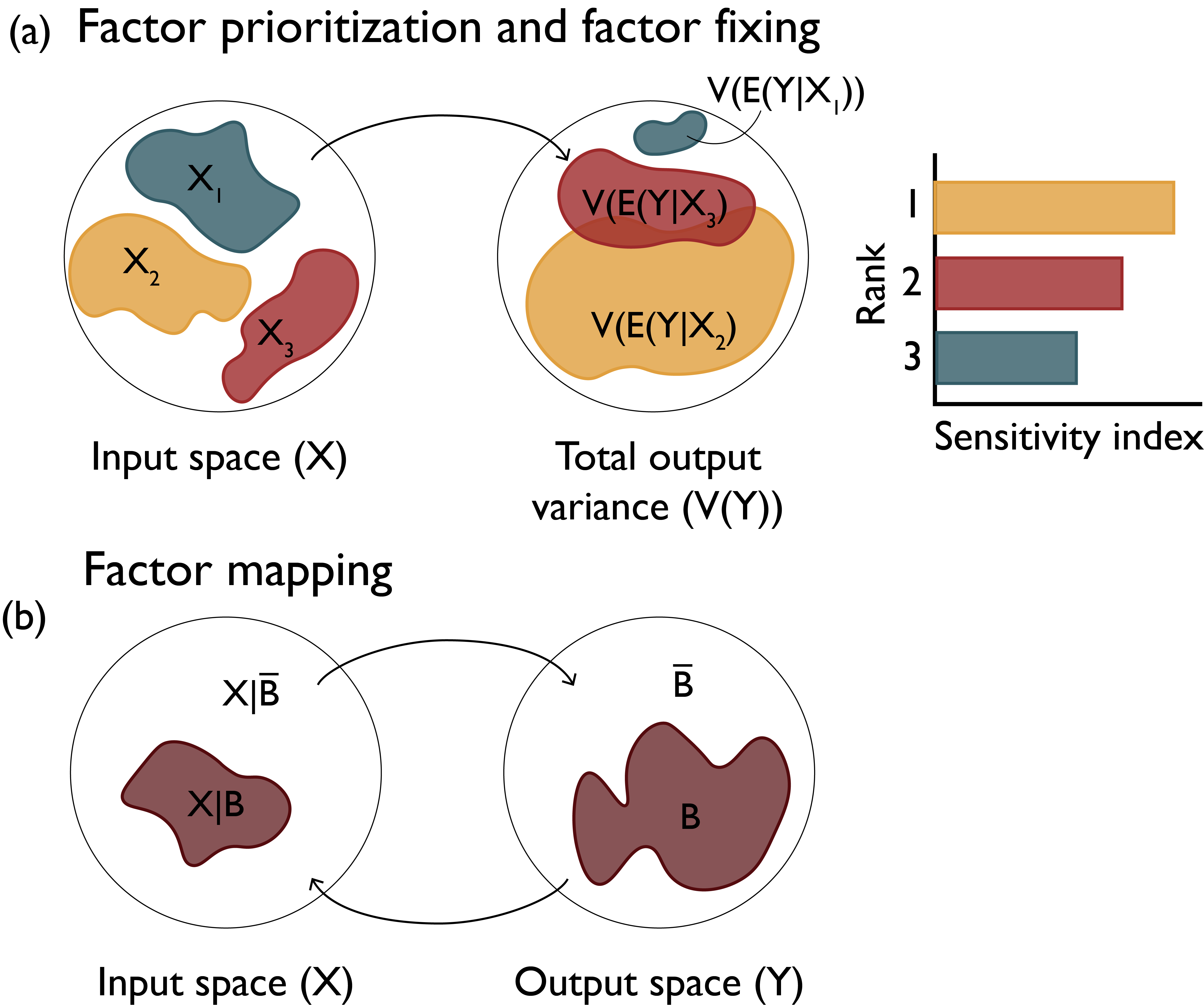Activating project at `~/Teaching/BEE4750/fall2023/slides`
Multiple Objectives and Tradeoffs
Lecture 27
November 20, 2023
Review and Questions
Sensitivity Analysis
- Sensitivity Analysis: How is uncertainty in the output(s) affected by uncertainty in the outputs?
Sensitivity Analysis: Modes
- Factor Prioritization
- Factor Fixing
- Factor Mapping

Source: Reed et al (2022)
Types of Sensitivity Analysis
- One-At-A-Time vs. All-At-Once
- Local vs. Global
Some Common Methods
- Perturbation/Derivatives (OAT, Local)
- Method of Morris (OAT, Global)
- Sobol’ (OAT/All At Once, Global)
- Regression: Linear Regression, Tree-based, Logistic (OAT/All At Once, Global)
Multiple Objectives
Multiple Objectives and Environmental Systems
Often have multiple objectives at play when designing or managing environmental systems:
Some examples:
- Cost
- Environmental quality
- Reliability/Variability
Example: Power Systems
- Total generation cost (including reserves);
- CO2 emissions;
- Resource adequacy (do we have enough resources available);
- Reliability;
- Other environmental impacts
Example: Reservoir Operations
- Municipal demand;
- Irrigation;
- Recreation;
- Hydropower potential;
- Flood management;
- Streamflow (ecosystem management)
How Can We Incorporate Multiple Objectives Into Models?
Approaches are method specific!
Key Question: what does it mean to “optimize” multiple objectives?
How Can We Incorporate Multiple Objectives Into Models?
Linear Programming:
- Identify thresholds and establish constraints for non-objective “objectives”;
- Weight objectives based on preferences, e.g. \[\min_\mathbf{x} Z(\mathbf{x}) = \sum_i w_i \hat{Z_i}(\mathbf{x}), \qquad \sum_i w_i =1\]
How Can We Incorporate Multiple Objectives Into Models?
Simulation-Optimization:
- Could use the LP approaches
- Can also have the simulation model (or wrapper) return multiple metrics
Back To The Key Question…
What does it mean to “optimize” multiple objectives?
Straightforward with weighting, requires but a priori elicitation of weights.
What about if we leave the objectives unaggregated?
Example: Lake Problem
Simulated 100 random decisions with two objectives:
- Maximize mean P releases
- Minimize probability of exceeding critical P concentration
Tradeoffs
There is a tradeoff between these two objectives:
Greater releases typically means lower reliability.
What does it mean to find an “optimum” across these two objectives?
Non-Dominated Decisions
We say that a decision \(\mathbf{x}\) is dominated if there exists another solution \(\mathbf{y}\) such that for every objective metric \(Z_i(\cdot)\), \[Z_i(\mathbf{x}) > Z_i(\mathbf{y}).\]
Non-Dominated Decisions
\(\mathbf{x}\) is non-dominated if it is not dominated by any \(\mathbf{y} \neq \mathbf{x}\).
Pareto Fronts
The set of non-dominated solutions is called the Pareto front (solutions are Pareto-optimal).
Every member of a Pareto front represents a different tradeoff between objectives.
A Priori vs A Posteriori Decision-Making
This gives us two frameworks for evaluating tradeoffs:
- A Priori: Establish weights ahead of time and combine objectives;
- A Posteriori: Identify Pareto-optimal solutions and then discuss what tradeoffs are tolerable.
Identifying Pareto Fronts
In higher dimensions, manually screening of a Pareto front is difficult.
Can use multi-objective optimization with (certain) evolutionary algorithms.
Key Takeaways
Key Takeaways
- Management of environmental systems often involves multiple objectives.
- Multiple objectives often have tradeoffs.
- Can combine multiple objectives with weights (a priori decision-making) or identifying non-dominated solutions (a posteriori decision-making)
- Set of non-dominated solutions (Pareto front) represent different choices about tradeoffs.
Course Review
Recap of Topics
Systems Dynamics and Models
- Nonlinear dynamics result in a need to view the entire system, not individual components.
- Models allow us to understand how a system could/would evolve under different conditions.
- No model is “right”, results in a need to consider relevant uncertainties.
Recap of Topics
Simulating Systems:
- Descriptive Modeling: using a model to generate data about how a system would behave
- Typically involves looping over a domain (spatial or temporal) and evaluating
- “Box” models
Recap of Topics
Decision-Making:
- Prescriptive Modeling: using a model to prescribe a decision
- Linear programming vs. simulation-optimization
- Can stress-test decisions for robustness or with sensitivity analysis
Recap of Examples
- Water quality
- Air quality
- Power systems
Key: These methods require domain knowledge but are generally applicable to all environmental systems management or design problems.
Upcoming Schedule
Upcoming Schedule
After Thanksgiving:
- Project check-ins
- Presentations due 12/4
- Peer reviews, posters, evaluations/lit reviews due 12/15.